Tall Towers & Sustainable Cities
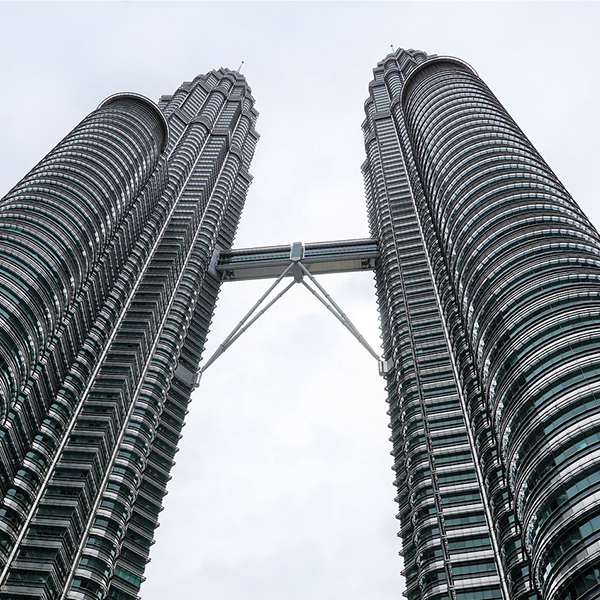
Skyscrapers (photosforyou, Pixabay)

Skyscrapers (photosforyou, Pixabay)
How does this align with my curriculum?
| Grade | Course | Topic |
|---|
Students will design and build a model apartment building and learn how buildings such as these can be a solution for suburban sprawl.
Overview
| Activities | Timing | Student Grouping | Description |
|---|---|---|---|
| Minds-On: Research and Understand the Problem | 20 minutes | Large group | Students review what internal and external forces are and begin to explore the purpose and uses of tall towers in the world. |
| Action: Design, Build and Test and Share a Prototype | 40 minutes | Small group | Students design, build and test a tall tower. |
| Consolidation: Tall Towers and Sustainable Cities | 20 minutes | Small group | Students explore the impact of tall towers on sustainable cities as a means to reduce suburban sprawl. |
This lesson can be done over a few days.
Students will:
- Learn about the different effects of internal and external forces on tall towers
- Use a collaborative engineering design process and associated skills to safely design and build a structure
- Learn about the impacts of suburban sprawl and how building apartments can help to mitigate this problem
Learning Goals
Students will:
- Learn about the different effects of internal and external forces on tall towers
- Use a collaborative engineering design process and associated skills to safely design and build a structure
- Learn about the impacts of suburban sprawl and how building apartments can help to mitigate this problem
Students can:
- Identify internal and external forces on towers that they have constructed through their labelled drawing and prototype testing
- Successfully create a tall tower that meets established criteria
- Identify issues associated with suburban sprawl and why apartment buildings can help to reduce it
Success Criteria
Students can:
- Identify internal and external forces on towers that they have constructed through their labelled drawing and prototype testing
- Successfully create a tall tower that meets established criteria
- Identify issues associated with suburban sprawl and why apartment buildings can help to reduce it
This icon indicates potential assessment opportunities
Observations
- Observe and record anecdotally students ability to actively listen and share ideas during large group discussions (Minds-on, Consolidation).
- Observe and record anecdotally students' ability to follow an engineering design process (Action).
- Listen to and record students as they share ideas for the criteria of the tall tower (Action).
- Observe and record using audio or video how students plan to go about building their tall towers (Action).
- Observe and record students’ safe use of tools and materials (Action).
Conversations
- Talk with students about their design sketches. Encourage students to describe their sketches in words and explain how their ideas meet the design criteria (Action).
- Talk with students about the process of building their tall towers, including challenges they encountered and how they overcame them (Consolidation).
Products
- Students could submit their notes and drawings that are part of the Build a Tall Tower Design Sketch Plan reproducible (Action).
- Students could submit completed Tall Towers & Sustainable Cities 3-2-1 Exit Slip reproducibles (Consolidation).
Evidence of Student Learning
This icon indicates potential assessment opportunities
Observations
- Observe and record anecdotally students ability to actively listen and share ideas during large group discussions (Minds-on, Consolidation).
- Observe and record anecdotally students' ability to follow an engineering design process (Action).
- Listen to and record students as they share ideas for the criteria of the tall tower (Action).
- Observe and record using audio or video how students plan to go about building their tall towers (Action).
- Observe and record students’ safe use of tools and materials (Action).
Conversations
- Talk with students about their design sketches. Encourage students to describe their sketches in words and explain how their ideas meet the design criteria (Action).
- Talk with students about the process of building their tall towers, including challenges they encountered and how they overcame them (Consolidation).
Products
- Students could submit their notes and drawings that are part of the Build a Tall Tower Design Sketch Plan reproducible (Action).
- Students could submit completed Tall Towers & Sustainable Cities 3-2-1 Exit Slip reproducibles (Consolidation).
Students will:
- Learn about the different effects of internal and external forces on tall towers
- Use a collaborative engineering design process and associated skills to safely design and build a structure
- Learn about the impacts of suburban sprawl and how building apartments can help to mitigate this problem
Learning Goals
Students will:
- Learn about the different effects of internal and external forces on tall towers
- Use a collaborative engineering design process and associated skills to safely design and build a structure
- Learn about the impacts of suburban sprawl and how building apartments can help to mitigate this problem
Students can:
- Identify internal and external forces on towers that they have constructed through their labelled drawing and prototype testing
- Successfully create a tall tower that meets established criteria
- Identify issues associated with suburban sprawl and why apartment buildings can help to reduce it
Success Criteria
Students can:
- Identify internal and external forces on towers that they have constructed through their labelled drawing and prototype testing
- Successfully create a tall tower that meets established criteria
- Identify issues associated with suburban sprawl and why apartment buildings can help to reduce it
This icon indicates potential assessment opportunities
Observations
- Observe and record anecdotally students ability to actively listen and share ideas during large group discussions (Minds-on, Consolidation).
- Observe and record anecdotally students' ability to follow an engineering design process (Action).
- Listen to and record students as they share ideas for the criteria of the tall tower (Action).
- Observe and record using audio or video how students plan to go about building their tall towers (Action).
- Observe and record students’ safe use of tools and materials (Action).
Conversations
- Talk with students about their design sketches. Encourage students to describe their sketches in words and explain how their ideas meet the design criteria (Action).
- Talk with students about the process of building their tall towers, including challenges they encountered and how they overcame them (Consolidation).
Products
- Students could submit their notes and drawings that are part of the Build a Tall Tower Design Sketch Plan reproducible (Action).
- Students could submit completed Tall Towers & Sustainable Cities 3-2-1 Exit Slip reproducibles (Consolidation).
Evidence of Student Learning
This icon indicates potential assessment opportunities
Observations
- Observe and record anecdotally students ability to actively listen and share ideas during large group discussions (Minds-on, Consolidation).
- Observe and record anecdotally students' ability to follow an engineering design process (Action).
- Listen to and record students as they share ideas for the criteria of the tall tower (Action).
- Observe and record using audio or video how students plan to go about building their tall towers (Action).
- Observe and record students’ safe use of tools and materials (Action).
Conversations
- Talk with students about their design sketches. Encourage students to describe their sketches in words and explain how their ideas meet the design criteria (Action).
- Talk with students about the process of building their tall towers, including challenges they encountered and how they overcame them (Consolidation).
Products
- Students could submit their notes and drawings that are part of the Build a Tall Tower Design Sketch Plan reproducible (Action).
- Students could submit completed Tall Towers & Sustainable Cities 3-2-1 Exit Slip reproducibles (Consolidation).
Materials and Preparation
| Material/Technology/Setting | Quantity |
|---|---|
|
For small group work |
|
1 per group |
|
For teacher use |
Materials
| Material/Technology/Setting | Quantity |
|---|---|
|
For small group work |
|
1 per group |
|
For teacher use |
- Collect the materials that students will use to construct the towers. Pre-cut any materials that are not safe or practical for students to cut in the classroom.
- Demonstrate how to safely and correctly use all the tools that are provided.
- Familiarize yourself with the Design & Build (Engineering design) process since students will be using this throughout the lesson.
- Review the slideshow in advance so you are familiar with where the animations occur.
Preparation
- Collect the materials that students will use to construct the towers. Pre-cut any materials that are not safe or practical for students to cut in the classroom.
- Demonstrate how to safely and correctly use all the tools that are provided.
- Familiarize yourself with the Design & Build (Engineering design) process since students will be using this throughout the lesson.
- Review the slideshow in advance so you are familiar with where the animations occur.
- Some familiarity with internal and external forces and how they occur.
Student Prior Knowledge and Skills
- Some familiarity with internal and external forces and how they occur.
| Material/Technology/Setting | Quantity |
|---|---|
|
For small group work |
|
1 per group |
|
For teacher use |
Materials
| Material/Technology/Setting | Quantity |
|---|---|
|
For small group work |
|
1 per group |
|
For teacher use |
- Collect the materials that students will use to construct the towers. Pre-cut any materials that are not safe or practical for students to cut in the classroom.
- Demonstrate how to safely and correctly use all the tools that are provided.
- Familiarize yourself with the Design & Build (Engineering design) process since students will be using this throughout the lesson.
- Review the slideshow in advance so you are familiar with where the animations occur.
Preparation
- Collect the materials that students will use to construct the towers. Pre-cut any materials that are not safe or practical for students to cut in the classroom.
- Demonstrate how to safely and correctly use all the tools that are provided.
- Familiarize yourself with the Design & Build (Engineering design) process since students will be using this throughout the lesson.
- Review the slideshow in advance so you are familiar with where the animations occur.
- Some familiarity with internal and external forces and how they occur.
Student Prior Knowledge and Skills
- Some familiarity with internal and external forces and how they occur.
Teaching and Learning Activities
This icon indicates potential assessment opportunities
Minds-On: Research and Understand the Problem (10 minutes)
| Instructions | Teaching Tips |
|---|---|
|
Activate prior knowledge by asking students to describe what a tower is and to name examples of tall towers that they know. During the discussion use a search engine to look up some of the towers that come up in conversation with the students. |
Community ConnectionsEncourage students to share examples from countries or places that have significance to them as well as any they have seen while travelling. |
|
Review the concepts of internal and external forces. In doing so, you may wish to show students this video that explains the external forces acting on structures and this video that explains the internal forces. It would also be useful to review the types of geometric shapes found in structures. |
IdeaYou could demonstrate how external forces could be applied by bending or twisting a plastic ruler, stretching a slinky toy or squeezing a sponge. DiscussionsSome discussion prompts can include:
|
Action: Design, Build and Test and Share Prototype (40-50
minutes)
| Instructions | Teaching Tips |
|---|---|
|
Go through the Tall Towers & Sustainable Cities slideshow with students [Google slides] [pptx] [PDF]. Use the title of each slide as a guide for classroom discussion. 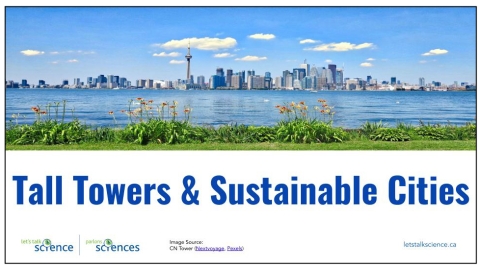
Pause the slideshow on slide 6 for students to begin the Design and Build activity. The final slides will be used during the consolidation activity. |
Images and VideosFor students who are visually impaired, use the descriptions provided in the alt text to describe the images. You could also use manipulatives to support students with low vision. |
|
As a class, have students co-construct success criteria that their prototype tall tower must meet. Note:
Students could use the Tall Tower Checklist [Google doc] [Word doc] [PDF] as a way to ensure their prototype fits the success criteria. 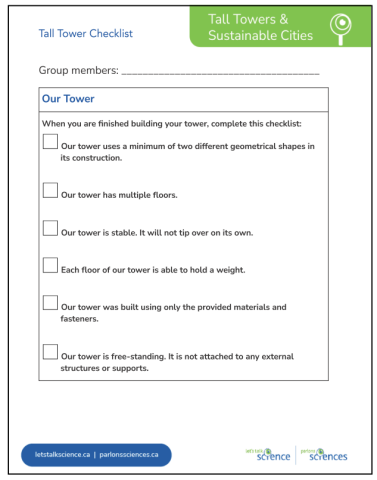
|
DiscussionsDuring brainstorming, ask students questions about how they can successfully reach this outcome. Some potential questions could be:
IdeaThe checklist can be modified to meet the criteria that are chosen. IdeaThe engineers, electricians, plumbers, carpenters, etc. who build buildings in the real world, have to follow specifications to ensure safety of the people living or working in the building as well as features the person paying for the building wants included. Checklists, such as this, are often used to make sure nothing is missed in a real world build. Have students practice making checklists and brainstorm what they think engineers would include. |
|
Have students complete the Build a Tall Tower Design Sketch Plan reproducible [Google doc] [Word doc] [PDF]. 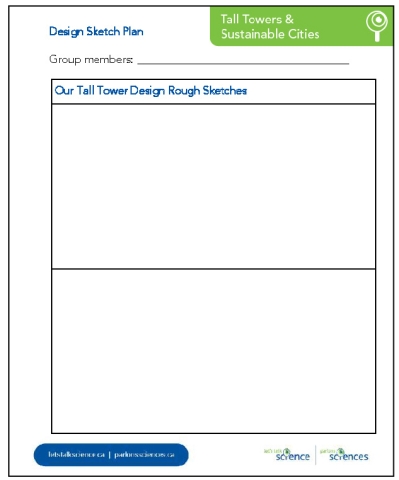
|
IdeaOn a whiteboard or chalkboard demonstrate how to label a design image. Show students how to label the materials they will be using and the different parts of the design. Ensure students understand how to include measurements on their design plan. IdeaStudents could use a digital program such as Google Draw or Jamboard to design their prototypes. DiscussionsYou could encourage and guide the students’ engineering design process with the following questions:
|
|
Have students build their tall tower based on the Design Sketch Plan. As they build the tower, have them use the reminders from the Design Sketch Plan to test the strength of the tower as they work, and encourage them to document this process and revise if required. On the final page of the plan, have students draw an image, or add a photograph, of their final tower. Students will label the drawing showing the locations of internal and external forces. 
Image - Text VersionShown is a colour photograph of a tower made from paper, straws and tape, on the floor.
|
IdeaAs students build their towers, have them test if each floor of the building can bear weight by having them place LEGO® people or LEGO® blocks on them. IdeaStudents could describe the forces on their towers in the form of a video, such as flipgrid. |
|
After confirming the towers meet the listed requirements, use a metre stick or measuring tape, record the heights of each of the towers and recognize the winning team. |
IdeaIn the construction of large, complex buildings, much of the work done in planning, designing and making sure the work is done according to the specifications and requirements, is carried out by Civil Engineers. These are people who use their scientific knowledge of forces and properties of materials to solve real world problems such as building a tower that does not fall down. Engineers use the knowledge created by scientists to build technology to solve real world problems. In a whole class brainstorm, ask students to list as many different types of jobs people would do in building a real skyscraper. The list should include architects, carpenters, electricians, plumbers, engineers, people who pour concrete, people who weld metal frames, people who keep the budgets, people who make sure everyone gets paid, etc. |
Consolidation: Tall Towers and Sustainable Cities (20 minutes)
| Instructions | Teaching Tips |
|---|---|
|
Open the Tall Towers & Sustainable Cities slideshow [Google slides] [pptx] [PDF] on slide 7. Use the title of each slide as a guide for classroom discussion. 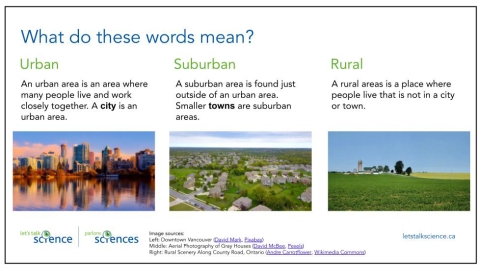
|
IdeaStudents could share their responses orally or using drawings instead of, or in addition to, writing. |
|
Students could fill out the Tall Towers & Sustainable Cities 3-2-1 Exit Slip reproducible [Google doc] [Word doc] [PDF]. 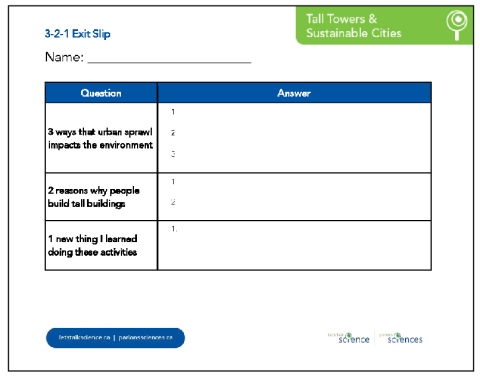
|
Background Information for Teachers
Tall Towers
Towers have been built in all shapes and sizes and for multiple purposes over the centuries. Today, many of the tallest towers house offices and homes.
Many cities have high rise apartments or condominiums in their city centres, which are convenient for people working downtown. They have other advantages, such as not having grass to cut or snow to shovel. So why aren’t more people living in these buildings?
For one thing, people often want to live in houses with yards they can spend time in. For another, more and more people don’t work downtown. They can work from home, which can be anywhere.
The challenge for urban planners of the future will be to design cities where people are happy to live and where the environment is protected.
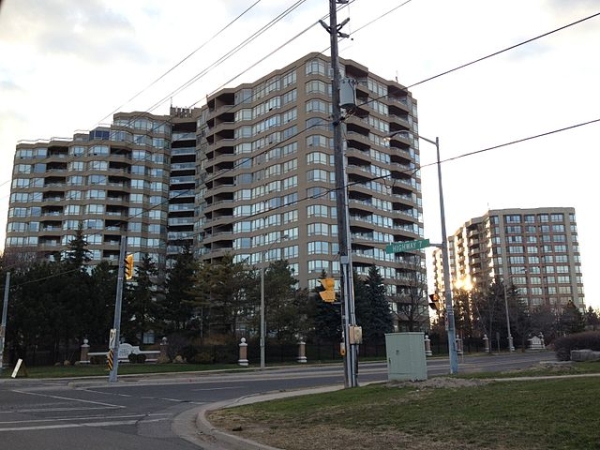
Image - Text Version
Shown is a colour photograph of two large buildings with many windows and balconies.
The camera looks across a street at two wide rectangular buildings of 15 to 20 storeys each. They are beige with wide windows that gleam with reflected sun. The lower storeys are obscured by evergreen trees, with street lights and power lines in front of them.
Additional Resources
Reproducibles
- Tall Towers & Sustainable Cities slideshow [Google slides] [pptx] [PDF]
- Tall Tower Checklist [Google doc] [Word doc] [PDF]
- Build a Tall Tower Design Sketch Plan reproducible [Google doc] [Word doc] [PDF]
- Tall Towers & Sustainable Cities 3-2-1 Exit Slip reproducible [Google doc] [Word doc] [PDF]
Books
Look at that Building
Read aloud version
By Scot Ritchie
Learning about buildings and how they are constructed has never been so much fun. This book introduces young readers to basic construction concepts through the eyes of five friends keen on building a doghouse for their pet pooch, Max.
ISBN: 9781554536962
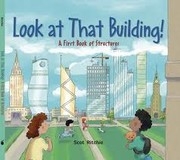
Videos
I Want To Be An Architect! - Kids Dream Jobs - Can You Imagine That?
In this video (5:00 min.) Ellery explains why he wants to be an architect when he grows up.
How to construct stronger buildings - from Fun Kids Inspiring Engineers
In this video (2:17 min.) students learn why large bases are important for structural stability.
Reproducibles and Media
Reproducibles
- Tall Towers & Sustainable Cities slideshow [Google slides] [pptx] [PDF]
- Tall Tower Checklist [Google doc] [Word doc] [PDF]
- Build a Tall Tower Design Sketch Plan reproducible [Google doc] [Word doc] [PDF]
- Tall Towers & Sustainable Cities 3-2-1 Exit Slip reproducible [Google doc] [Word doc] [PDF]
Books
Look at that Building
Read aloud version
By Scot Ritchie
Learning about buildings and how they are constructed has never been so much fun. This book introduces young readers to basic construction concepts through the eyes of five friends keen on building a doghouse for their pet pooch, Max.
ISBN: 9781554536962

Videos
I Want To Be An Architect! - Kids Dream Jobs - Can You Imagine That?
In this video (5:00 min.) Ellery explains why he wants to be an architect when he grows up.
How to construct stronger buildings - from Fun Kids Inspiring Engineers
In this video (2:17 min.) students learn why large bases are important for structural stability.
Science
- Students could consider ways to make their structures more resistant to external forces, such as wind. They could then modify their structures and test using a fan.
Literacy
- Students could write a sample letter to a city council advocating for the building of more apartments.
Mathematical Thinking
- Students could measure and record the length, width, height and mass of their towers using standard units. They could record the data using a variety of methods (e.g., a table). For example, students may record:
- the dimensions of the tower
- the length of pieces of material
- the load the tower can support
- Students could create town plans using interlocking blocks, such as LEGO®, to represent houses. They could determine the area that the blocks occupy. They could then stack the blocks to create an apartment building and calculate how much area was saved by doing this.
Computational Thinkings
- Students could design apartment buildings using the Minecraft: Education Edition. Many inspiring videos and tutorials are available through YouTube.
Visual Arts
- Students could embellish their structure to make them look like real apartment buildings. This could include adding walls with windows, stairs, landscaping, etc.
Extensions
Science
- Students could consider ways to make their structures more resistant to external forces, such as wind. They could then modify their structures and test using a fan.
Literacy
- Students could write a sample letter to a city council advocating for the building of more apartments.
Mathematical Thinking
- Students could measure and record the length, width, height and mass of their towers using standard units. They could record the data using a variety of methods (e.g., a table). For example, students may record:
- the dimensions of the tower
- the length of pieces of material
- the load the tower can support
- Students could create town plans using interlocking blocks, such as LEGO®, to represent houses. They could determine the area that the blocks occupy. They could then stack the blocks to create an apartment building and calculate how much area was saved by doing this.
Computational Thinkings
- Students could design apartment buildings using the Minecraft: Education Edition. Many inspiring videos and tutorials are available through YouTube.
Visual Arts
- Students could embellish their structure to make them look like real apartment buildings. This could include adding walls with windows, stairs, landscaping, etc.
Will there ever be a mile-high skyscraper? (2019)
In this video (6:07 min.) learn what goes into building very tall buildings.
Bigger is Greener: The Environmental Benefits of High-Density Housing (2021)
This article from Livingat300Main, outlines some of the benefits of high-density housing.
Discourage urban sprawl
This page of the David Suzuki Foundation website discusses what Canadians can do to reduce urban sprawl.
Using AI to map urban sprawl in Canada (2022)
This page of the Radio Canada website has an interactive showing how AI was used to measure urban sprawl in some of Canada’s major cities.
Learn More
Will there ever be a mile-high skyscraper? (2019)
In this video (6:07 min.) learn what goes into building very tall buildings.
Bigger is Greener: The Environmental Benefits of High-Density Housing (2021)
This article from Livingat300Main, outlines some of the benefits of high-density housing.
Discourage urban sprawl
This page of the David Suzuki Foundation website discusses what Canadians can do to reduce urban sprawl.
Using AI to map urban sprawl in Canada (2022)
This page of the Radio Canada website has an interactive showing how AI was used to measure urban sprawl in some of Canada’s major cities.
Civil Mentors (Apr. 8, 2019) Tension and Compression Forces in Buildings [Video]. YouTube.
The Daily (Feb. 9, 2022). Canada’s Large Urban Centres Continue To Grow And Spread. Statistics Canada.
David Suzuki Foundation (n.d.). Discourage Urban Sprawl.
Jaeger, JAG, and N. Nazarnia (2016). Social and ecological impacts of the exponential increase of urban sprawl in Montreal. The Canada Communicable Disease Report 42: 207-208.
References
Civil Mentors (Apr. 8, 2019) Tension and Compression Forces in Buildings [Video]. YouTube.
The Daily (Feb. 9, 2022). Canada’s Large Urban Centres Continue To Grow And Spread. Statistics Canada.
David Suzuki Foundation (n.d.). Discourage Urban Sprawl.
Jaeger, JAG, and N. Nazarnia (2016). Social and ecological impacts of the exponential increase of urban sprawl in Montreal. The Canada Communicable Disease Report 42: 207-208.
Reproducibles
- Tall Towers & Sustainable Cities slideshow [Google slides] [pptx] [PDF]
- Tall Tower Checklist [Google doc] [Word doc] [PDF]
- Build a Tall Tower Design Sketch Plan reproducible [Google doc] [Word doc] [PDF]
- Tall Towers & Sustainable Cities 3-2-1 Exit Slip reproducible [Google doc] [Word doc] [PDF]
Books
Look at that Building
Read aloud version
By Scot Ritchie
Learning about buildings and how they are constructed has never been so much fun. This book introduces young readers to basic construction concepts through the eyes of five friends keen on building a doghouse for their pet pooch, Max.
ISBN: 9781554536962

Videos
I Want To Be An Architect! - Kids Dream Jobs - Can You Imagine That?
In this video (5:00 min.) Ellery explains why he wants to be an architect when he grows up.
How to construct stronger buildings - from Fun Kids Inspiring Engineers
In this video (2:17 min.) students learn why large bases are important for structural stability.
Reproducibles and Media
Reproducibles
- Tall Towers & Sustainable Cities slideshow [Google slides] [pptx] [PDF]
- Tall Tower Checklist [Google doc] [Word doc] [PDF]
- Build a Tall Tower Design Sketch Plan reproducible [Google doc] [Word doc] [PDF]
- Tall Towers & Sustainable Cities 3-2-1 Exit Slip reproducible [Google doc] [Word doc] [PDF]
Books
Look at that Building
Read aloud version
By Scot Ritchie
Learning about buildings and how they are constructed has never been so much fun. This book introduces young readers to basic construction concepts through the eyes of five friends keen on building a doghouse for their pet pooch, Max.
ISBN: 9781554536962

Videos
I Want To Be An Architect! - Kids Dream Jobs - Can You Imagine That?
In this video (5:00 min.) Ellery explains why he wants to be an architect when he grows up.
How to construct stronger buildings - from Fun Kids Inspiring Engineers
In this video (2:17 min.) students learn why large bases are important for structural stability.
Science
- Students could consider ways to make their structures more resistant to external forces, such as wind. They could then modify their structures and test using a fan.
Literacy
- Students could write a sample letter to a city council advocating for the building of more apartments.
Mathematical Thinking
- Students could measure and record the length, width, height and mass of their towers using standard units. They could record the data using a variety of methods (e.g., a table). For example, students may record:
- the dimensions of the tower
- the length of pieces of material
- the load the tower can support
- Students could create town plans using interlocking blocks, such as LEGO®, to represent houses. They could determine the area that the blocks occupy. They could then stack the blocks to create an apartment building and calculate how much area was saved by doing this.
Computational Thinkings
- Students could design apartment buildings using the Minecraft: Education Edition. Many inspiring videos and tutorials are available through YouTube.
Visual Arts
- Students could embellish their structure to make them look like real apartment buildings. This could include adding walls with windows, stairs, landscaping, etc.
Extensions
Science
- Students could consider ways to make their structures more resistant to external forces, such as wind. They could then modify their structures and test using a fan.
Literacy
- Students could write a sample letter to a city council advocating for the building of more apartments.
Mathematical Thinking
- Students could measure and record the length, width, height and mass of their towers using standard units. They could record the data using a variety of methods (e.g., a table). For example, students may record:
- the dimensions of the tower
- the length of pieces of material
- the load the tower can support
- Students could create town plans using interlocking blocks, such as LEGO®, to represent houses. They could determine the area that the blocks occupy. They could then stack the blocks to create an apartment building and calculate how much area was saved by doing this.
Computational Thinkings
- Students could design apartment buildings using the Minecraft: Education Edition. Many inspiring videos and tutorials are available through YouTube.
Visual Arts
- Students could embellish their structure to make them look like real apartment buildings. This could include adding walls with windows, stairs, landscaping, etc.
Will there ever be a mile-high skyscraper? (2019)
In this video (6:07 min.) learn what goes into building very tall buildings.
Bigger is Greener: The Environmental Benefits of High-Density Housing (2021)
This article from Livingat300Main, outlines some of the benefits of high-density housing.
Discourage urban sprawl
This page of the David Suzuki Foundation website discusses what Canadians can do to reduce urban sprawl.
Using AI to map urban sprawl in Canada (2022)
This page of the Radio Canada website has an interactive showing how AI was used to measure urban sprawl in some of Canada’s major cities.
Learn More
Will there ever be a mile-high skyscraper? (2019)
In this video (6:07 min.) learn what goes into building very tall buildings.
Bigger is Greener: The Environmental Benefits of High-Density Housing (2021)
This article from Livingat300Main, outlines some of the benefits of high-density housing.
Discourage urban sprawl
This page of the David Suzuki Foundation website discusses what Canadians can do to reduce urban sprawl.
Using AI to map urban sprawl in Canada (2022)
This page of the Radio Canada website has an interactive showing how AI was used to measure urban sprawl in some of Canada’s major cities.
Civil Mentors (Apr. 8, 2019) Tension and Compression Forces in Buildings [Video]. YouTube.
The Daily (Feb. 9, 2022). Canada’s Large Urban Centres Continue To Grow And Spread. Statistics Canada.
David Suzuki Foundation (n.d.). Discourage Urban Sprawl.
Jaeger, JAG, and N. Nazarnia (2016). Social and ecological impacts of the exponential increase of urban sprawl in Montreal. The Canada Communicable Disease Report 42: 207-208.
References
Civil Mentors (Apr. 8, 2019) Tension and Compression Forces in Buildings [Video]. YouTube.
The Daily (Feb. 9, 2022). Canada’s Large Urban Centres Continue To Grow And Spread. Statistics Canada.
David Suzuki Foundation (n.d.). Discourage Urban Sprawl.
Jaeger, JAG, and N. Nazarnia (2016). Social and ecological impacts of the exponential increase of urban sprawl in Montreal. The Canada Communicable Disease Report 42: 207-208.